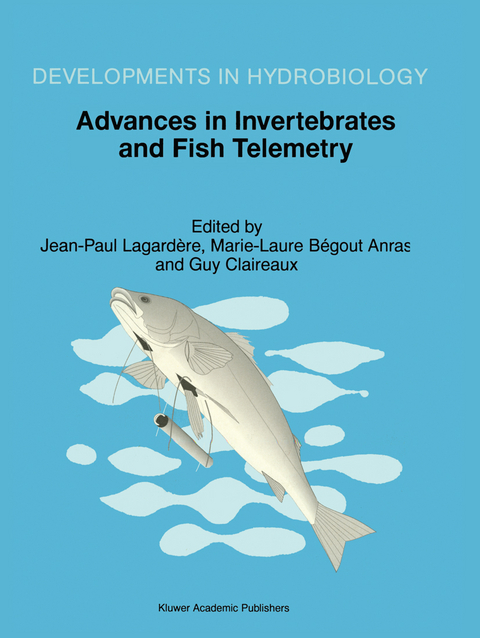
Advances in Invertebrates and Fish Telemetry
Springer (Verlag)
978-0-7923-5211-2 (ISBN)
Methodology and New Developments,
Tagging Procedures,
Behavioural and Physiological Ecology,
Fish Migration,
Stock Management and Conservation.
Particular emphasis was put on tag miniaturisation, multiple functions and sampling strategies.
Papers concerned the effects of tags on fish for consolidating behavioural or original physiological investigations noticeably more open to the marine environment. Methods were essentially applied to study the relationships between fish and their natural environment.
Besides providing up-to-date information on the state of fish telemetry, the book illustrates the increase in spatial and temporal scales and the number of tracked fish which gives a statistical basis for field study in behavioural ecology.
1. Methodology and New Developments.- Applications and performance of Radio-Acoustic Positioning and Telemetry (RAPT) systems.- A comparison of theoretical estimates of the errors associated with ultrasonic tracking using a fixed hydrophone array and field measurements.- Selection of optimal positioning intervals in fish tracking: an experimental study on Barbus barbus.- Inland migration study of sea trout (Salmo trutta) into the rivers Rhine and Meuse (The Netherlands), based on inductive coupling radio telemetry.- Development of miniature pingers for tracking Atlantic salmon smolts at sea.- A dynamic combined acoustic and radio-transmitting tag for diadromous fish.- Frequency choice for radio telemetry: the HF vs. VHF conundrum.- Simultaneous observations of tuna movements and their prey by sonic tracking and acoustic surveys.- A data logger tag for the study of slaughter procedures in aquacultured salmon.- 2. Tagging Procedures.- Growth and physiological responses to surgical and gastric radio transmitter implantation techniques in subyearling chinook salmon (Oncorhynchus tshawytscha).- Use of miniature radio-transmitters to track the movements of dace, Leuciscus leuciscus (L.) in the River Frome, Dorset.- The effects of Passive Integrated Transponder tags on survival and growth of juvenile brown trout (Salmo trutta L.) and their use for studying movements in a small river.- Evaluation of surgery procedures for tagging eel Anguilla anguilla (L.) with biotelemetry transmitters.- A method for the external attachment of acoustic tags on roundfish.- Regurgitation rates of intragastric transmitters by adult Atlantic salmon (Salmo salar L.) during riverine migration.- 3. Behavioural and Physiological Ecology.- New approaches to the behavioural ecology of decapod crustaceans using telemetry and electronic tags.- Electromagnetic telemetry of lobster (Homarus gammarus (L.)) movements and activity: preliminary results.- Basic movement pattern and chemo-oriented search towards baited pots in edible crab (Cancer pagurus L.).- Telemetry applied to behaviour analysis of yellowfin tuna (Thunnus albacares, Bonnaterre, 1788) movements in a network of fish-aggregating devices.- Spawning migration of radio-tagged landlocked Arctic Charr, Salvelinus alpinus L. in Ennerdale Lake, the English Lake District.- Acoustic tracking of the dispersal of organic matter by scavenging fishes in the deep-sea.- Seasonal variations in time and space utilization by radio-tagged yellow eels Anguilla anguilla (L.) in a small stream.- Reactions of cod (Gadus morhua L.) in the pre-vessel zone to an approaching trawler under different light conditions: preliminary results.- Changes in vertical distribution of sea bass (Dicentrarchus labrax L.) during a hypoxic episode.- Heart rate telemetry to study environmental influences on fish metabolic expenditure.- Effects of thermal environment on electromyographical signals obtained from Atlantic salmon (Salmo salar L.) during forced swimming.- Remote monitoring of heart rate as a measure of recovery in angled Atlantic salmon, Salmo salar (L.).- Using speed-sensing transmitters to construct a bioenergetics model for subadult lemon sharks, Negaprion brevirostris (Poey), in the field.- 4. Fish Migration and Stock Management.- Migratory and reproductive activity of radio-tagged Arctic char (Salvelinus alpinus L.) in northern Labrador.- Environmental unpredictability rules the autumn migration of brown trout (Salmo trutta L.) in the Belgian Ardennes.- Spawning migration of sea trout (Salmo trutta (L.)) in a Danish river.- A radio telemetry study of the migration of Atlantic salmon (Salmo salar L.) and sea trout (Salmo trutta trutta L.) in the upper Rhine.- The migratory behaviour of wild Atlantic salmon (Salmo salar L.) smolts in the River Test and Southampton Water, southern England.- Movements of a bream (Abramis brama (L.)), rudd × bream hybrid, tench (Tinca tinea (L.)) and pike (Esox lucius (L.)) in an Irish canal habitat.- Radio telemetry as a tool to study habitat use of nase (Chondrostoma nasus L.) in medium-sized rivers.- The migratory behaviour of juvenile and adult salmonids in relation to an estuarine barrage.- Movements of adult sea trout Salmo trutta L. in the tailrace of a low-head dam at W?oc?awek hydroelectric station on the Vistula River, Poland.- Migration of adult Atlantic salmon (Salmo salar (L.)); the effects of artificial freshets.- Survival of radio-tagged Atlantic salmon (Salmo salar (L.)) and trout (Salmo trutta L.) smolts passing a reservoir during seaward migration.- The efficiency of a nature-like bypass channel for pike-perch (Stizostedion lueioperca (L.)) in the Marchfeldkanalsystem.
| Erscheint lt. Verlag | 31.10.1998 |
|---|---|
| Reihe/Serie | Developments in Hydrobiology ; 130 |
| Zusatzinfo | XI, 360 p. |
| Verlagsort | Dordrecht |
| Sprache | englisch |
| Maße | 203 x 254 mm |
| Themenwelt | Naturwissenschaften ► Biologie ► Evolution |
| Naturwissenschaften ► Biologie ► Ökologie / Naturschutz | |
| Naturwissenschaften ► Biologie ► Zoologie | |
| ISBN-10 | 0-7923-5211-4 / 0792352114 |
| ISBN-13 | 978-0-7923-5211-2 / 9780792352112 |
| Zustand | Neuware |
| Haben Sie eine Frage zum Produkt? |
aus dem Bereich


